INTRODUCTION
The importance of plants as future sources of natural antimicrobial agents holds great promise. Plants are inexpensive and proved to be effective medicines to cure myriad of diseases from mild microbial infections to complex diseases, including cancers and devastating infectious diseases, such as tuberculosis, caused by Mycobacterium tuberculosis with much less side effects when compared to the synthetic drugs (Abuzeid et al., 2014; Eklund et al., 2010; Koko et al., 2008). These advantages have encouraged scientists of different disciplines from chemistry to pharmacology to intensively screen for the plants as promising candidates for medicines to replace currently used synthetic drugs (Abdallah, 2011; Cragg and Newman, 2013; Zulkipli et al., 2015). One of the big problems that is greatly challenging the public health is the rapid growing resistance developed by infectious microorganisms against many synthetic drugs notably those frequently used against infectious diseases, such as food poisons, urinary tract, respiratory, and digestive systems (Cragg and Newman, 2013; Nascimento et al., 2000; Saga and Yamaguchi, 2009). Some of the most threatening multi-drug resistant (MDR) microorganisms are Staphylococci, Streptococci, Salmonella, and M. tuberculosis (MDR-TB) owing to the high rates of horiztubeontal gene transfer that confers an MDR in these microorganisms even between evolutionarily distant species (Munita et al., 2017; Ventola, 2015). Hence, there is an urgent demand for antimicrobial agents, especially those with narrow spectra to minimize the rapid spread of resistance among infectious microorganisms (Chandra et al., 2017; Ventola, 2015). To this end, researchers have turned eyes toward plants as a rich and ancient source of various active compounds of medicinal importance for producing next-generation drugs that could possibly overcome the MDR challenges, especially for problematic infectious agent, such as MDR-TB (Chandra et al., 2017).
One of the most intriguing medicinal plants that has been used widely in the traditional medicine is the Costus Saussurea lappa (Decne.) C. B. Clarke., which is widely used, along with other costus species, in many developing countries in Asia (Pandey et al., 2007; Waly, 2009). The S. lappa is a member of Asteraceae family, a family that is rich with well-known medicinal plants of highly economic importance. Many of which have been intensively studied for their phytochemical constituents and medicinal applications, including S. lappa (Pandey et al., 2007). The S. lappa root in particular has been widely prescribed for various infectious and physiological diseases, including jaundice, diarrhea, stomachache, respiratory tract infections, antispasmodic agents against spasms caused by asthma, rheumatism, leprosy, cholera, and chronic skin diseases among others (Gwari et al., 2013; Kala and Manjerkar, 1999; Kapoor, 2001). For example, many studies have also shown that different extracts of S. lappa possess various pharmacological activities, including hepatoprotective, anti-inflammatory, anti-cancer, and anti-ulcer properties (Chen et al., 1995; Cho et al., 2004; Li et al., 2005). This wide range of biological activities can be confidently attributed to the richness of S. lappa in pharmacologically active ingredients (Pandey et al., 2007). Phytochemical constituents, such as diosgenin, prosapogenin B of dioscin, diosgenone, cycloartanol, 25-en-cycloartenol, and octacosanoic acid, were isolated from the costus rhizomes (Qiao et al., 2002). The major constituents of S. lappa were found to be sesquiterpene lactones, such as saussurea lactone (Rao and Verma, 1951) and isodeydrocostus lactone (Kalsi et al., 1983). Active sesquiterpenes lactones, such as costunolide and dehydrocostus lactone, were previously isolated from the methanolic extracts of S. lappa (Shoji et al., 1986), and appeared to have an anti-inflammatory activity that causes an inhibition of the production of the tumor necrosis factor alpha in murine macrophage-like cells as well as possessing a strong anti-cancer activity when mixed together (Damre et al., 2003; Peng et al., 2017; Sunkara et al., 2010).
Different extracts of S. lappa roots, including hexane, chloroform, ethylacetate ether, methanol, and water extracts, have been reported to have various antibacterial and antifungal activities against several pathogenic bacteria, such as Staphylococcus aureus, Staphylococcus epidermidis, Salmonella typhi, Salmonella typhimurium, Streptococcus mutans, Escherichia coli, Pseudomonas aeruginosa, and Bacillus subtilis and fungi, such as Trichophyton rubrum, T. mentagrophytes, and Magnaporthe grisea (Negi et al., 2013; Ray and Mjumdar, 1977). For instance, the methanol extract of S. lappa was found to be effective against the growth and acid production activity of the S. mutans (Chang et al., 2012; Yu et al., 2007). It has also been demonstrated that the methanol extract of S. lappa can lower the adherence of S. mutans in a concentration dependent manner as well as inhibiting the biosynthesis of water-insoluble glucan, an extracellular polysaccharide substance produced by S. mutans that is implicated in dental caries (Yu et al., 2007).
To further our understanding on the phytochemistry and biological activities of S. lappa root, we applied gas chromatography/mass spectrometry (GC/MS) analyses on the essential oil composition of the aqueous and ethanol extracts and used these extracts to assess their antimicrobial activities against two bacterial isolates the S. aureus and Salmonella sp. representing Gram +ve and Gram –ve strains, respectively.
MATERIALS AND METHODS
Plant materials
Roots of S. lappa were purchased from general herbal market in Khartoum, Sudan. Taxonomical identification and authentication were taken place at the Herbarium of Medicinal and Aromatic Plants and Traditional Medicine Research Institute of the National Center for Research in Khartoum, Sudan. Voucher specimen was deposited to the same Herbarium of the National Center for Research in Khartoum, Sudan.
Microorganisms
To assess the antibacterial properties of the S. lappa root extracts two bacterial isolates of Gram +ve S. aureus and Gram –ve Salmonella sp. were kindly provided by the Department of Microbiology and Molecular Biology, Faculty of Science and Technology at Al Neelain University, Khartoum, Sudan. These bacterial strains were confirmed by applying conventional biochemical methods and prepared accordingly for further antibacterial tests.
Preparation of extracts
Root specimens were grounded into a fine powder and sample of 50 g was carefully loaded onto Soxhlet extractor (Pyrex, Germany) and extracted with 300 ml of 99.9% ethanol (248 Worli road, Mumbai-30) for 3 hours as described somewhere else (Pandey and Tripathi, 2014). The solvent was separated from the crude extract using rotary evaporator at 60°C for 30 minutes and then the extract was kept at the room temperature to allow drying gently. For aqueous extraction the same steps were followed by replacing the ethanol with water.
Gas chromatography mass spectrometry analyses
For qualitative and quantitative assessment of the essential oil components of the ethanol and aqueous extracts of the S. lappa roots, GC/MS analyses were performed using a Shimadzu GCMS-QP2010 Ultra (Shimadzu, Japan) equipped with a capillary column Rtx-5MS of 30 m × 0.25 mm ID with a film thickness of 0.25 μm according to a standard protocol (Pongpiachan et al., 2009; 2011). Before injection of a 1 μl of respective extract was dissolved in an equal volume of ethanol and ultrasonicated to homogeneity and mixed well with 0.1 g of anhydrous sodium sulfate before passing the mixture through syringe filter with 0.22 μm pore size. One microliter of the filtrate was injected directly into the capillary column to obtain chromatographic separation. Helium gas was used as a carrier in a flow rate of 1.69 ml/minute. The temperatures of the injector and the mass detector were maintained at 200°C and 250°C, respectively, and the column oven temperature was programed at 50°C–300°C with an initial increase of 7°C/minute until it reaches 180°C then the increment of temperature was raised to 10°C/minute up to the final temperature for an optimal separation of peaks. Electron ionization was operated with 70 eV. Using scan mode, all the mass spectra were recorded in a range of 40–500 m/z (mass to charges ratio) for a total run time of 28 minutes and the identification of ethanol and water extracts components was conducted by comparing the obtained retention times and mass fragmentation with the documented retention indices available in the library of the National Institute of Standards and Technology.
Well-diffusion antibacterial assay
All the experiments were done in Mueller Hinton Agar medium (MHA) (Mumbai-400086, India) which was prepared according to the manufacturer protocol. To evaluate the antibacterial activities of the different extracts against S. aureus and Salmonella sp. a well-diffusion antibacterial assay method was used. In brief, freshly prepared MHA plates were cut with a sterile cork borer under aseptic environment to make four wells with a diameter of 10 mm per plate (Miller et al., 2002). Bacterial suspensions of 18 hours incubation were initially plated homogenously on MHA plates and three different concentrations of 50%, 100%, and 200% of 40 mg/ml ethanol or water extracts were used to fill the well with 50 μl/well from each concentration and plates were then kept at the room temperature for 2 hours to diffuse completely before incubated at 37°C for additional 18 hours. After incubation, the diameter of the growth inhibition zones was measured in millimeter (mm) and each extracts were assayed for at least three times against each bacterial isolate. For positive control, standard antibiotic azithromycin was used following the same protocol except that antibiotic discs were used instead of solution (i.e., disc-diffusion method).
RESULTS AND DISCUSSION
GC/MS profiling of Saussurea lappa aqueous and ethanol extracts
Saussurea lappa is a well-known medicinal plant that has been widely prescribed as whole plant, rhizome, or root in the traditional medicine in different developing countries in Asia (Pandey et al., 2007). The isolated compounds from S. lappa, such as costunolides and dehydrocostus lactones, were found to be effective against various microbial infections as well as exerting better anti-cancer properties against breast cancer (Kalsi et al., 1995; Kumar et al., 1995; Pandey et al., 2007; Peng et al., 2017). In addition to these compounds, cynaropicrin, a sesquiterpene lactone, was found to exhibit a range of diverse bioactivities, such as anti-inflammation and anti-cancer activities (Cho et al., 1998). In order to expand our knowledge in this important medicinal plant and further investigate the reasons behind the strong antibacterial activities of S. lappa that have been shown, in many previous studies, to have convincingly various pharmacological activities, such as anti-inflammatory, anti-ulcer, hepatoprotective, and antimicrobial activities (Chen et al., 1995; Damre et al., 2003; Li et al., 2005; Matsuda et al., 2000; Venkataranganna et al., 1998), we have chosen the S. lappa roots (Fig. 1) that is available commercially for medicinal purposes and analyzed, using GC/MS approach, the chemical constituents found in the aqueous and ethanol extracts of the plant roots. The results obtained from the GC/MS analysis have led to the identification of a total of 37 and 18 compounds in the ethanol and aqueous extracts, respectively (Tables 1 and 2). As shown in the GC/MS chromatogram (Fig. S1), the ethanol extract of S. lappa has more phyto-constituents with almost double the number of compounds identified in the aqueous extract (Fig. S2). This is consistent with a previous study which reported that S. lappa and S. costus are rich in the phyto-constituents and that the GC/MS analysis of their ethanol extracts resulted in the identification of 39 and 41 compounds, respectively, with sesquiterpenes as major component (Gwari et al., 2013; Maurer and Grieder, 1997; Negi et al., 2013).
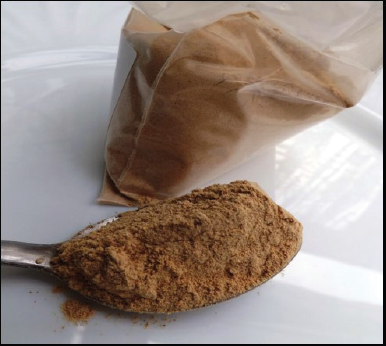 | Figure 1. Sample of Saussurea lappa roots powder used for the GC-MS analysis and subsequent antimicrobial activity. [Click here to view] |
The ethanol extract in the present study as indicated from the GC/MS profile gave rise to several (8–10) compounds with significant peak areas when compared to that of the aqueous extract (5–7), indicating that ethanol solvent is superior in extracting GC/MS detectable phyto-constituents in comparison with that of water (Table 1; Figs. S1 and S2). Those compounds with significant peak areas (%) detected in the ethanol extract are; cyclodecacyclotetradecene,14,15-didehydro- (29a), 1,3-propanediol,2-(hydroxymethyl)-2-nitro- (15a), bufa-20,22-dienolide,14,15-epoxy-3,11-dihydroxy- (32a), bicycle(5.3.0)decane,2-methylene-5-(1-methylvinyl)-8- (23a), isosteviol methyl ester (31a), 2(3H)-benzofuranone,6-ethyenlhexahydro-6-methylene-7- (25a), 4,7,10,13,16,19-docosahexaenoic acid, methyl ester (28a), and androstan-17-one,3-ethyl-3-hydroxy-,(5.alpha)- (19a), which gave rise to peak areas (%) of 39.59, 11.05, 5.91, 4.36, 3.97, 3.88, 3.18, and 3.01, respectively (Fig. S1). In contrast, aqueous extract analyses by GC/MS has revealed that compounds cyclodecacyclotetradecene,14,15-didehydroxy (14b), cholest-7-en-3-ol,4-methyl-,(3.beta.,4.alpha)- (18b), 2(3H)-benzofuranone,6-ethenythexhydroxy- (12b), .Alpha.-Guaiene (10b), 3-oxatricyclo(20.8.0.0(7,16))triaconta-1- (16b), 9,12,15-octadecatrienoic acid,(z,z,z)- (8b), and cyclohexane,1,2-diethenyl-4-(1-methyle-(9b) are dominant with peak areas (%) of 61.69, 5.10, 4.42, 4.17, 3.49, 3.47, and 3.12, respectively (Fig. S2). Figure 2 shows the deduced structures of some of these compounds detected in significant levels in both ethanol and aqueous extracts. Compound 29a (14b), for example, was found to be the major component of both aqueous (61.69%) and ethanol (39.59%) extracts (Fig. S1 and S2). Interestingly, compound 25a (12b), commonly known as dehydrosaussurea lactone with a molecular structure of C15H20O2 (Fig. 2B), was found in reasonable amounts in both extracts with a slightly higher concentration in the aqueous extract than the ethanol extract. This sesquiterpene lactone is very similar structurally to another sesquiterpene lactone called costunolide, was previously isolated from the methanol extract of S. lappa and found to be a major component in the root volatile oil (Govindan and Bhattacharaya, 1977; Gwari et al., 2013; Maurer and Grieder, 1997; Shoji et al., 1986). This compound, in a combination with constunolide (C15H20O2), has been recently shown to exhibit a better anti-breast cancer activity by inducing cell cycle arrest and apoptotic action against cancerous cell indicating the significance medicinal properties of this compound (Peng et al., 2017). Compound 31a, Isosteviol methyl ester (C21H32O3), was found only in the ethanol extract with significant amount (3.97%) (Table 1). This compound is regarded as a bio-active agent and has been shown to reduce the oxidative stress and arsenic-DNA induced damage beside its capability to induce apoptosis against cancerous cells (Das et al., 2013). In addition, compound 28a, a fatty acid methyl ester, was only found in the ethanol extracts with somewhat increased level (3.18%). Such fatty acid methyl ester compounds were found to possess potential medicinal activities against various microorganisms (Chandrasekaran et al., 2008).
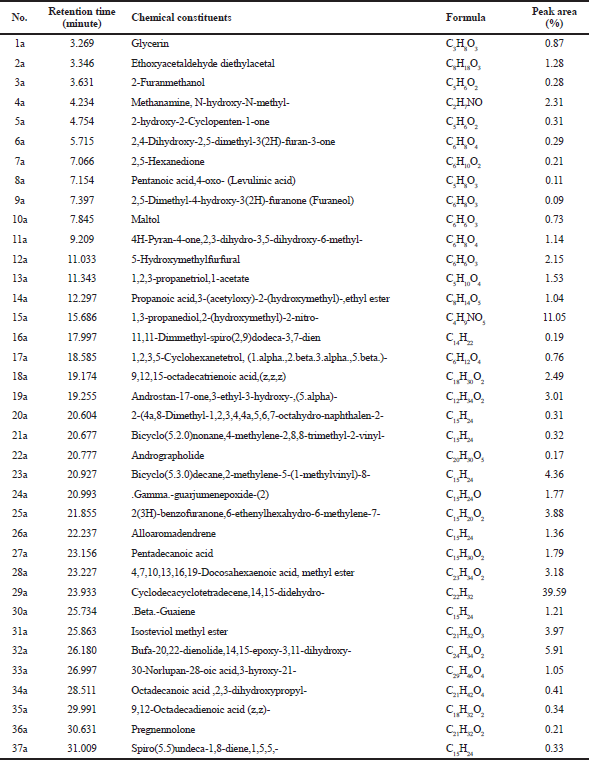 | Table 1. GC/MS analyses of the ethanol extract of the S. lappa root indicating the percentages and the chemical constituents corresponding to the major peaks in the chromatogram. [Click here to view] |
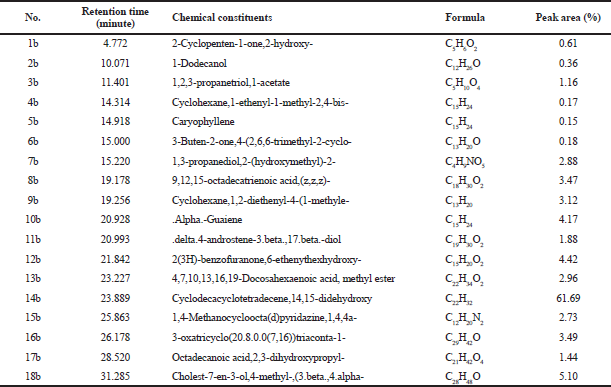 | Table 2. GC/MS analyses if the aqueous extract of the S. lappa root indicating the percentage and chemical constituents corresponding to the major peaks in the chromatogram. [Click here to view] |
Other compounds of significant medicinal and biological interests were identified in trace amounts in the aqueous and ethanol extracts (Tables 1 and 2). Intriguingly, compounds 2a (dodecan-1-ol), and 5a (caryophyllene), a sesquiterpene, which were identified only in the aqueous extract (Table 2), whereas, compounds andrographolide (22a), gamma-gurjunenepoxide-(2) (24a), and alloaromadendrene (26a) were detected only in the ethanol extract (Table 1). These compounds were found to have various biological activities as demonstrated in many previous studies (Banerjee et al., 2017; Dahham et al., 2015; De Lima et al., 2016; Sonboli et al., 2006; Tyagi et al., 2013).
Anti-bacterial activities of ethanol and aqueous extracts
The anti-bacterial activities of the S. lappa of both the ethanol and aqueous extracts were evaluated using a well-diffusion method against S. aureus (G +ve) and Salmonella sp. (G –ve) isolates with azithromycin as a positive control (Figs. 3–5). The results showed that both the ethanol and aqueous extracts exhibited antibacterial activity against S. aureus, whereas no antibacterial effect was noticed against Salmonella sp. isolate (Figs. 4 and 5). This result may be due to a developing resistance of this strain against anti-microbial agents found in the S. lappa root or a lack of effective agents against Gram –ve bacteria as indicated by its resistance to the azithromycin control which has somewhat shallow antibacterial activity (Fig. 3). This is plausible since Salmonella isolates is known for its ability to develop rapid resistance against available antibiotics as reported in many previous studies (Skov et al., 2007; Su et al., 2004). In accordance with the present study, Parekh and Chanda (2007) reported that the aqueous extract of S. lappa is inactive against some isolated bacteria and has some activities against others, including a standard S. typhimurium (ATCC 23564). A previous study has attributed the antibacterial activities of S. costus rhizome extracts against G +ve S. aureus, S. epidermidis and G –ve E. coli and S. typhimurium to the presence of diosgenin, a bioactive phytosteroid sapogenin compound (C27H42O3) (Ariharan et al., 2012). Interestingly, similar compounds were found in detectable amounts in both extracts, i.e., compounds 32a and 18b (Table 2). Therefore, the results showing that ethanol and aqueous extracts have exclusive activities against S. aureus but not Salmonella sp. may be attributed to these compounds and that such compounds have no apparent antimicrobial properties against our Salmonella sp. isolate or this isolate has already developed a resistance against these compounds or similar ones. Similarly, the ethanol extracts of S. lappa was found to be effective against caries-causing bacteria S. mutans which significantly lower the adherence of the microbe as well as inhibiting its growth and acid production (Yu et al., 2007). Nonetheless, the mechanism behind such activity against G +ve bacteria and resistance to our Salmonella isolate is not clear in the present study and further study is request to draw a decisive conclusion.
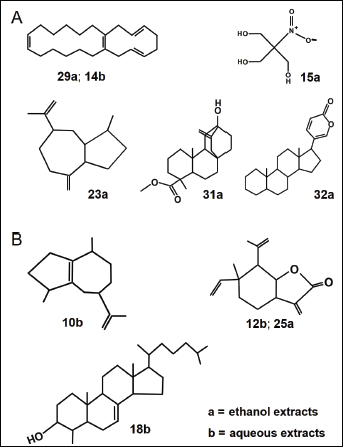 | Figure 2. Chemical structures of some of the phyto-constituents detected in the ethanol and aqueous extracts. These compounds are 29a(14b), Cyclohexane, 1,2-diethenyl-4-(1-methyle-); 15a, 1,3-prpanediol,2-(hydroxymethyl)-2-; 23a, Bicyclo(5.3.0)decane,2-methylene-5-(1-methylvinyl)-8-; 31a, Isosteviol methyl ester; 32a, Bufa-20,22-dienolide,14,15-epoxy-3,11-dihydroxy-; 10b, alpha.-Guaiene; 12b(25a), 2(3H)-benzofuranoze,6-ethenythexhydroxy-; and 18b, Cholest-7en-3-ol,4-methyl-,(3.beta.,4.alpha-). [Click here to view] |
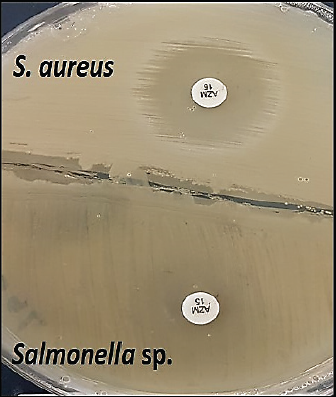 | Figure 3. Antibacterial sensitivity test of Azithromycin (control) against S. aureus and Salmonella sp isolates. [Click here to view] |
Generally, the ethanol extract was more effective against S. aureus with inhibition zones ranging between 18 and 20 mm than the aqueous extracts which showed mean inhibition zones around 15 mm at higher concentrations (>20 mg/ml) (Figs. 4 and 5). This can be confidently attributed to the richness of ethanol extracts of S. lappa root with bio-active compounds and possibly that a synergetic action of two or more of such active compounds might have occurred to inhibit the growth of S. aureus in our MHA media. Compounds 22a, 28a, and 31a that have been known for their potential medicinal activities and found exclusively in the ethanol extracts (Chandrasekaran et al., 2008; Das et al., 2013). In support of this interpretation, S. aureus strain was found to be more sensitive to compound 22a, andrographolide, with a minimal inhibitory concentration of 100 μg/ml, which is comparable to the amount detected in the ethanol extract found in the present study (Banerjee et al., 2017). All together, the significant antimicrobial activity of the ethanol extract against S. aureus may be due to the action of these unique compounds found only in the ethanol and/or the presence of a highly active compound such as 22a in the ethanol extract and its absence from the aqueous extract.
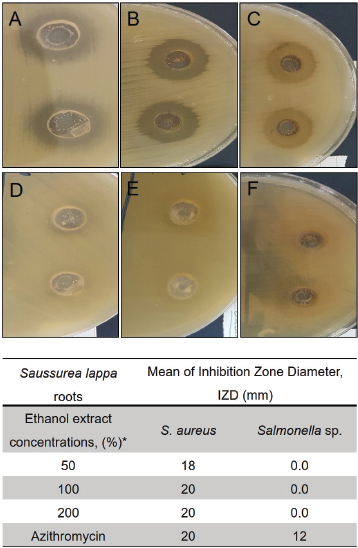 | Figure 4. The antibacterial activities of the ethanol extracts from S. lappa roots against S. aureus and Salmonella sp. at different concentrations. (A) The effect of 50% of 40 mg/l crude ethanol extract against Gram +ve S. aureus, (B) 100% of 40 mg/l crude, and (C) 200% of 40 mg/l. (D) The effect of 50% of 40 mg/l crude, (E) 100% of 40 mg/l, and (F) 200% of 40 mg/l crude against the Gram ‒ve Salmonella sp. [Click here to view] |
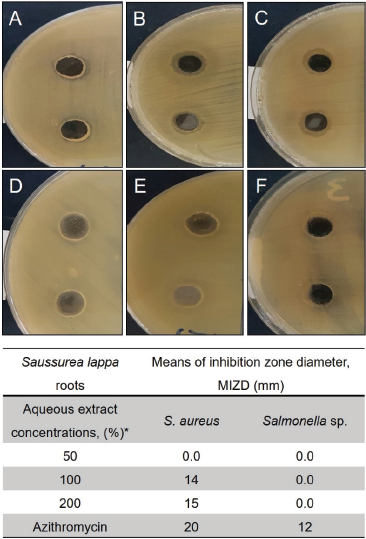 | Figure 5. The antibacterial activities of the aqueous extracts from S. lappa roots against the Gram +ve S. aureus and Gram ‒ve Salmonella sp at different. (A) The effect of 50%, (B) 100%, and (C) 200% aqueous extracts against S. aureus. (D) The effects of 50%, (E) 100%, and (F) 200% of the aqueous extracts against Salmonella sp. [Click here to view] |
CONCLUSION
In conclusion, we demonstrate that S. lappa root is rich in various bioactive compounds as indicated in the GC/MS profiles of the ethanol and aqueous extracts. The study also revealed that the ethanol extract is more effective as antibacterial agent against G +ve S. aureus owing to the richness of this extract with several bioactive compounds which were not detected in the aqueous extracts. We also conclude, based on the condition followed in this study, that the S. lappa root has no effects against G –ve strain Salmonella sp. Hence, further studies are required to investigate the antibacterial effects of S. lappa extracts and understand their mode of actions to help found an antibacterial agent that would compete the conventional antibiotics.
ACKNOWLEDGMENTS
The authors would like to thank the staff of the University of Medical Sciences and Technology-UMST for the technical support and allowing them using the GC/MS instrument. The authors would also like to thank the laboratory staff of the departments of Biochemistry and Molecular Biology and Microbiology and Molecular Biology, Faculty of Science & Technology, Al Neelain University. FHMK is thankful to Mrs. Kaltoum Ali Cabeer from the Department of Biology and Biotechnology, Al Neelain University for critical reading of the manuscript.
FINANCIAL SUPPORT
None.
CONFLICT OF INTEREST
All authors declare that there is no conflict of interest.
AUTHORS’ CONTRIBUTIONS
AMM conceived and supervised the overall work; OREE and OIMA performed all of the experiments; FHMK analyzed data, and drafted the manuscript; AMM and FHMK commented and discussed the final manuscript with input from other authors.
REFERENCES
Abdallah EM. Plants: an alternative source for antimicrobial. J Appl Pharm Sci, 2011; 1:16–20. CrossRef
Abuzeid N, Kalsum S, Larsson M, Glader M, Andersson H, Raffetseder J, Pienaar E, Eklund D, Alhassan MS, AlGadir HA, Koko WS, Schön T, Mesaik MA, Abdalla OM, Khalid A, Lerm M. Antimycobacterial activity of selected medicinal plants traditionally used in Sudan to treat infectious diseases. J Ethnopharmacol, 2014; 157:134–9.
Ariharan VN, Meena-Deri VN, Rajakokhila M, Prasad PN. Antibacterial activity of Costus speciosus rhizome extract on some pathogenic bacteria. Int J Adv Life Sci, 2012; 4:24–7.
Banerjee M, Parai D, Chattopadhyay S, Mukherjee SK. Andrographolide: antibacterial activity against common bacteria of human health concern and possible mechanism of action. Folia Microbiol (Praha), 2017; 62:237–44. CrossRef
Chandra H, Bishnoi P, Yadav A, Patni B, Mishra AP, Nautiyal AR. Antimicrobial resistance and the alternative resources with special emphasis on plant-based antimicrobials—a review. Plants, 2017; 6:16; doi: 10.3390/plants6020016. CrossRef
Chandrasekaran M, Kannathasan K, Venkatesaln V. Antimicrobial activity of fatty acid methyl esters of some members of Chenopodiaceae. Z Naturforsch, 2008; 63:331–6. CrossRef
Chang K-M, Choi S-I, Kim G-H. Anti-oxidant activity of Saussurea lappa C.B. Clarke roots. Prev Nutr Food Sci, 2012; 17:306–9. CrossRef
Chen HC, Chou CK, Lee SD, Wang JC, Yeh SF. Active compounds from Saussurea lappa Clarke that suppress hepatitis B virus surface antigen gene expression in human hepatoma cells. Antiviral Res, 1995; 27:99–109. CrossRef
Cho JY, Kim AR, Jung JH, Chun T, Rhee MH, Yoo ES. Cytotoxic and pro-apoptotic activities of cynaropicrin, a sesquiterpene lactone, on the viability of leukocyte cancer cell lines. Eur J Pharmacol, 2004; 492:85–94. CrossRef
Cho JY, Park J, Yoo ES, Baik KU, Jung JH, Lee J, Park MH. Inhibitory effect of sesquiterpene lactones from Saussurea lappa on tumor necrosis factor-alpha production in murine macrophage like cells. Planta Medica, 1998; 64:594–7. CrossRef
Cragg GM, Newman DJ. Natural products: a continuing source of novel drug leads. Biochim Biophys Acta, 1830; 3670–95. CrossRef
Dahham SS, Tabana YM, Igbal MA, Ahmed MB, Ezzat MO, Majid AS, Majid AM. The anticancer, antioxidant and antimicrobial properties of the sesquiterpene β-caryophyllene from the essential oil of Aquilaria crassna. Molecules, 2015; 20:11808–29. CrossRef
Damre AA, Damre AS, Saraf MN. Evaluation of sesquiterpene lactone fraction of Saussurea lappa on transudative, exudative and proliferative phases of inflammation. Phytother Res, 2003; 17:722–5. CrossRef
Das S, Das J, Samadder A, Khuda-Bukhsh AR. Dihydroxy-isosteviol methyl ester from Pulsatilla nigricans induces apoptosis in HeLa cells: its cytotoxicity and interaction with Calf thymus DNA. Phytother Res, 2013; 27:664–71. CrossRef
De Lima BR, da Silva FM, Soares ER, de Almeida RA, da Silva Fiho FA, Pereira Junior RC, Hernandez Tasco AJ, Salvador MJ, Koolen HH, de Sourza AD, Pinheiro ML. Chemical composition and antimicrobial activity of the essential oils of Onychopetalum amazonicum R.E.Fr. Nat Prod Res, 2016; 30:2356–9. CrossRef
Eklund D, Welin A, Schon T, Stendahl O, Huygen K, Lerm M. Validation of a medium-throughput method for evaluation of intracellular growth of Mycobacterium tuberculosis. Clin Vaccine Immunol, 2010; 17:513–7. CrossRef
Govindan SV, Bhattacharaya SC. Alantolides and cyclocostunolides from Saussurea lappa. Indian J Chem, 1977;15:956.
Gwari G, Bhandari U, Andola HC, Lohani H, Chauhan N. Volatile constituents of Saussurea costus roots cultivated in Uttarakhand Himalayas, India. Pharmacogn Res, 2013; 5:179–82. CrossRef
Kala CP, Manjerkar N. Ethnomedicobotany of Indian Trans Himalaya. A case study from Spiti. J Econ Taxon Bot, 1999; 23:177–83.
Kalsi PS, Kumar S, Jawanda GS, Chhabra BR. Guaianolides from Saussurea lappa. Phytochemistry, 1995; 40:1713–5. CrossRef
Kalsi PS, Sharma S, Kaur G. Isodehydrocostus lactone and isozaluzanin C. Two guaianolides from Saussurea lappa. Phytochemistry, 1983; 22:1993–5. CrossRef
Kapoor LD. Handbook of ayurvedic medicinal plants. CRC Press, Washington, DC, pp. 299–300, 2001.
Koko WS, Mesaik MA, Yousaf S, Galal M, Choudhary MI. In vitro immunomodulating properties of selected Sudanese medicinal plants. J Ethnopharmacol, 2008; 118:26–34. CrossRef
Kumar S, Ahuja NM, Juawanda GS, Chhabra BR. New guaianolides from Saussurea lappa roots. Fitoterapia, 1995; 66:287–8.
Matsuda H, Kageura T, Inoue Y, Morikawa T, Yoshikawa M. Absolute stereo structures and syntheses of saussureamines A, B, C, D, and E, a, ino acid-sesquiterpene conjugates with gastro-protective effect from the roots of Saussurea lappa. Tetrahedron, 2000; 56:7763–77. CrossRef
Maurer B, Grieder A. Sesquiterpenoids from Costus root oil (Saussurea lappa Clarke). Helvetica Chimica Acta, 1997; 60:2177–90. CrossRef
Miller D, Marangon F, Romano A, Alfonso E, Gonzalez S. Evaluation of an agar well diffusion assay to validate and correlate in vitro efficacy of topical antibacterial and antifungal preparations with conventional susceptibility techniques. Invest Ophthalmol Vis Sci, 2002; 43:1608.
Munita JM, Shelburne S, Greenburg DE, Arias CA. The growing threat of antimicrobial resistance. Tex Med, 2017; 113:48–52.
Nascimento GGF, Locatelli J, Freitas PC, Silva GL. Antibacterial activity of plant extracts and phytochemicals on antibiotic-resistant bacteria. Braz J Microbiol, 2000; 31:247–56. CrossRef
Negi S, Bisht VK, Bhandari AK, Bhatt VP, Sati MK, Mohanty JP, Sundriyal RC. Antidiarrheal activity of methanol extract and major essential oil contents of Saussurea lappa Clarke. Afr J Pharm Pharmacol, 2013; 7:474–7. CrossRef
Pandey MM, Rastogi S, Singh Rawat AK. Saussurea costus: Botanical, chemical and pharmacological review of an ayurvedic medicinal plant. J Ethnopharmacol, 2007; 110:379–90. CrossRef
Pandey S, Tripathi S. Concept of standardization, extraction and pre-phytochemical screening strategies for herbal drug. J Pharma Phytochem, 2014; 2:115–9.
Parekh J, Chanda S. Antibacterial and phytochemical studies on twelve species of Indian medicinal plants. Afr J Biomed Res, 2007; 10:175–81. CrossRef
Peng ZX, Wang Y, Fan JH, Lin XJ, Liu CY, Xu Y, Ji WD, Yan C, Su CQ. Costunolide and dehydrocostuslactone combination treatment inhibit breast cancer by inducing cell cycle arrest and apoptosis through c-Myc/p53 and AKT/14-3-3 pathway. Sci Rep, 2017; 7:41254; doi: 10.1038/srep41254. CrossRef
Pongpiachan S, Hirunyatrakul P, Kittikoon L, Khumsup C. Parameters influencing on sensitivities of polycyclic aromatic hydrocarbons measured by Shimadzu GCMS-QP2010 Ultra. In: Mohd MA, editor. Advanced gass chromatography—progress in agricultural, biomedical and industrial applications. Intech China, Shanghai, pp. 109–30, 2012.
Pongpiachan S, Bualert S, Sompongchalyakul P, Kositanont C. Factors affecting sensitivity and stability of polycyclic aromatic hydrocarbons. Anal Lett, 2009; 42:2106–30. CrossRef
Qiao CF, Li QW, Dong H, Xu LS, Wang ZT. Studies on chemical constituents of two plants from costus. Zhongguo Zhong Yao Za Zhi, 2002; 27:123–5.
Ray PG, Mjumdar SK. Antifungal activity of Saussurea lappa Clarke. Indian J Exp Bio, 1977; 15:344.
Rao PS, Verma BS. Isolation of a new lactone from the resinoid of costus roots. J Sci Ind Res, 1951; 10:166.
Saga T, Yamaguchi K. History of antimicrobial agents and resistant bacteria. J Jpn Med Assoc, 2009; 137:103–8.
Shoji N, Umeyama A, Saits N, Takemoto T. Vasoactive substances from Saussurea lappa. J Nat Prod, 1986; 49:1112–3. CrossRef
Skov MN, Andersen JS, Aabo S, Ethelberg S, Aarestrup FM, Sorensen AH, Sorensen G, Pedersen K, Nordentoft S, Olsen KEP, Gener-Smidt P, Baggesen DL. Antimicrobial drug resistance of Salmonella isolates from meat and humans, Denmark. Emerg Infect Dis, 2007; 13:638–41. CrossRef
Sonboli A, Babakhani B, Mehrabian AR. Antimicrobial activity of six constituents of essential oil from Salvia. Z Naturforsch C, 2006; 61:160–4. CrossRef
Su LH, Chin CH, Chu C, On JT. Antimicrobial resistance in nontyphoid Salmonella serotypes: a global challenge. Clin Infect Dis, 2004; 39:546–51. CrossRef
Sunkara Y, Robinson A, Suresh B, Naidu K, Vishnuvardhan M, Ramakrishna S, Madhavendra SS, Rao JM. Anti-inflammatory and cytotoxic activity of chloroform extract of roots of Saussurea lappa. J Pharm Res, 2010; 3:1775–8.
Tyagi AK, Bukvicki D, Gottardi D, Veljic M, Guerzoni ME, Malik A, Marin PD. Antibacterial potential and chemical characterization of Serbian liverwort (Porella arboris-vitae): SEM and TEM observations. Evid Based Complement Alternat Med, 2013; 2013:e382927. CrossRef
Venkataranganna MV, Gopumadhavan S, Sundaram R, Mitra SK. Evaluation of possible mechanism of anti-ulcerogenic activity of UL-409, an herbal preparation. J Ethnopharmacol, 1998; 63:187–92.
Ventola CL. The antibiotic resistance crisis: Part 1: causes and threats. Pharm Ther, 2015; 40:277–83. CrossRef
Waly NM. Verifying the scientific name of costus [Saussurea lappa ((Decne.) C.B. Clarke)—Asteraceae]. JKAU Sci, 2009; 21:327–34; doi: 10.4197/Sci.21-2.10.
Li Y, Xu C, Zhang Q, Liu JY, Tan RX. In vitro anti-Helicobacter pylori action of 30 Chinese herbal medicines used to treat ulcer diseases. J Ethnopharmacol, 2005; 98:329–33. CrossRef
Yu HH, Lee JS, Lee KH, Kim KY, You YO. Saussurea lappa inhibits the growth, acid production, adhesion and water-insoluble glucan synthesis of Streptococcus mutans. J Ethnopharmacol, 2007; 111:413–7. CrossRef
Zulkipli IN, David SR, Rajabalaya R, Idris A. Medicinal plants: a potential source of compounds for targeting cell division. Drug Target Insights, 2015; 9:9–19. CrossRef
Supplementary Materials
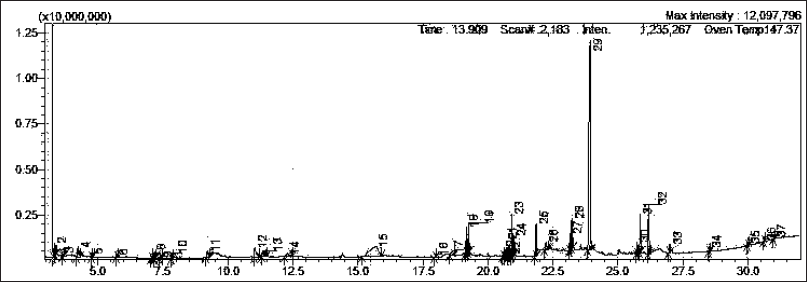 | Figure S1. GC/MS representative chromatogram from the analyses of the ethanol extracts of the essential oil of the S. lappa roots. [Click here to view] |
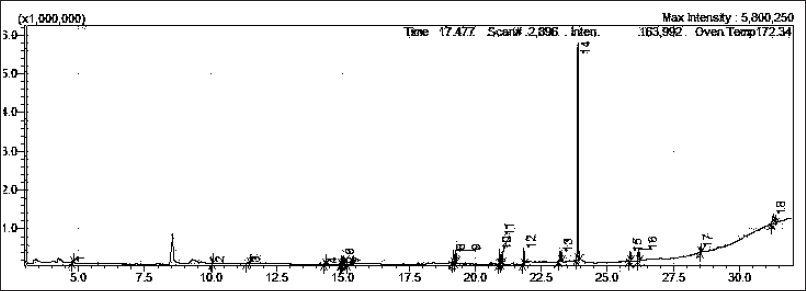 | Figure S2. GC/MS representative chromatogram from the analyses of the aqueous extracts of the essential oil extracted from the S. lappa roots in this study. [Click here to view] |